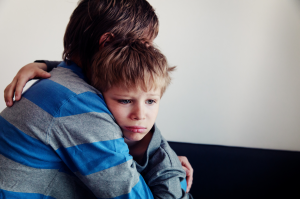News
October 21, 2022
/Pro Tips
Pro Tips: Autism and Grief
 Pro Tips provided by Rebecca Meyer, MS, MSW, social worker at Summit Academy Enhanced.
Pro Tips provided by Rebecca Meyer, MS, MSW, social worker at Summit Academy Enhanced.
At some point, we all must deal with the difficult and emotional experience of losing a loved one. Explaining death and grief to individuals with autism can be complex, especially when parents and caregivers may be having a difficult time themselves. Below are some tips on how to talk to your child about loss:
1. Explain death as fully as possible.
Take the initiative to talk to your child about death before the loss of a loved one. Use clear, concrete terms like dead or died, and avoid vague phrases like gone to a better place or gone to sleep. Children with autism often think in literal terms, so vague phrasing can be difficult for them to fully understand.
It’s just as important to help nonverbal children process a death as well. If your child is nonverbal, use an assistive device or pictures to help facilitate communication.
If appropriate, explain the wake and funeral process. Social stories can also help a child understand what to expect after a loved one dies.
2. Reassure your child.
Let your child see your natural emotions. Explain that everyone grieves differently and it’s okay to show your emotions. Use reminders and visuals of actions they can do when they have these feelings. For example, if they’re feeling sad, they can hug they’re stuffed animal.
Sometimes children with autism will say or do something that seems inappropriate to the situation. Know that this is normal and avoid commenting on it. Instead validate their expression by acknowledging that there are many ways to feel.
There’s often a delay in processing a death for a child with autism. You may not notice a change until months later and it may appear in unexpected ways, such as toilet training regression or aggressive behaviors. Ask if they’re thinking about their loved one, what you can do to help, and if they want to talk about the person.
3. Remember your loved ones.
Remembering loved ones can be a source of comfort. Help your child understand it’s okay to talk about the person and to share their feelings. Share your own thoughts, memories, and feelings about the person. Consider creating a photo album that you can look at with your child. You could also do something fun to honor the person, like cooking a favorite meal that they liked to make.
4. Keep other aspects of life consistent.
Children with autism are often used to a schedule, and changes to that routine can be difficult. Planning services for a loved one, visiting with family members and friends, wakes, and funerals can disrupt a family’s normal routine. No longer seeing a family member your child was close to can also be a difficult change for them. Resume your child’s normal schedule as soon as possible to help reduce anxiety.